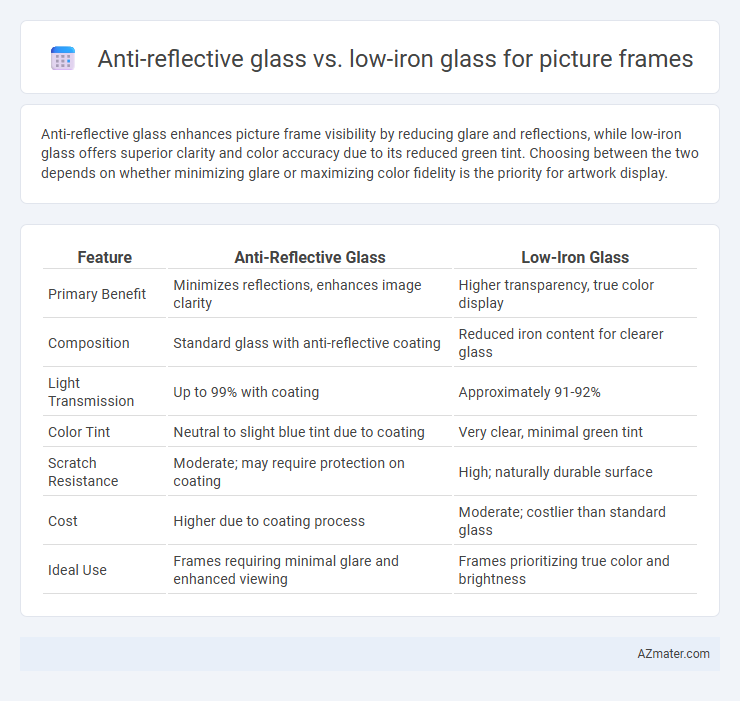Anti-reflective glass enhances picture frame visibility by reducing glare and reflections, while low-iron glass offers superior clarity and color accuracy due to its reduced green tint. Choosing between the two depends on whether minimizing glare or maximizing color fidelity is the priority for artwork display.
Table of Comparison
| Feature | Anti-Reflective Glass | Low-Iron Glass |
|---|---|---|
| Primary Benefit | Minimizes reflections, enhances image clarity | Higher transparency, true color display |
| Composition | Standard glass with anti-reflective coating | Reduced iron content for clearer glass |
| Light Transmission | Up to 99% with coating | Approximately 91-92% |
| Color Tint | Neutral to slight blue tint due to coating | Very clear, minimal green tint |
| Scratch Resistance | Moderate; may require protection on coating | High; naturally durable surface |
| Cost | Higher due to coating process | Moderate; costlier than standard glass |
| Ideal Use | Frames requiring minimal glare and enhanced viewing | Frames prioritizing true color and brightness |
Introduction to Picture Frame Glass Options
Anti-reflective glass reduces glare and reflections, enhancing the visibility of artwork in picture frames by using a special coating that minimizes light interference. Low-iron glass offers superior clarity and color fidelity due to its reduced iron content, providing a crystal-clear view ideal for preserving the original colors of framed images. Choosing between anti-reflective and low-iron glass depends on whether glare reduction or maximum visual clarity is the primary concern for the display environment.
What is Anti-Reflective Glass?
Anti-reflective glass features a special coating that reduces glare and reflections, enhancing the visibility and clarity of artwork or photographs in picture frames. This coating minimizes light distortion, allowing viewers to see colors and details more accurately compared to standard or low-iron glass. Low-iron glass offers higher transparency and less green tint but does not specifically target reflection reduction like anti-reflective glass designed for optimal display quality.
What is Low-Iron Glass?
Low-iron glass is a type of glass with reduced iron content, resulting in higher clarity and greater light transmission compared to standard glass, making it ideal for picture frames that require true color representation and minimal green tint. Anti-reflective glass features a special coating that significantly reduces glare and reflections, enhancing visibility of the artwork behind the glass. For picture frames, low-iron glass is preferred when color accuracy and transparency are paramount, while anti-reflective glass is chosen to minimize visual distractions caused by ambient light.
Visual Clarity: Anti-Reflective vs Low-Iron Glass
Anti-reflective glass minimizes glare by reducing surface reflections up to 99%, enhancing visual clarity and color accuracy in picture frames. Low-iron glass offers higher light transmission, around 91%, resulting in a clearer, brighter view with less green tint compared to standard glass. When prioritizing visual clarity, anti-reflective glass excels in environments with strong lighting, while low-iron glass provides a natural, crisp look with enhanced transparency.
Glare Reduction Comparison
Anti-reflective glass significantly reduces glare by minimizing surface reflections, enhancing the visibility of artwork behind the frame without color distortion, making it ideal for brightly lit environments. Low-iron glass offers higher clarity and less green tint compared to standard glass but does not reduce glare as effectively, often resulting in noticeable reflections under direct light. Choosing anti-reflective glass ensures superior glare reduction for picture frames, while low-iron glass prioritizes color accuracy and transparency.
Color Accuracy and Image True-to-Life Display
Anti-reflective glass significantly enhances color accuracy by reducing glare and minimizing light distortion, ensuring images appear vibrant and true-to-life in picture frames. Low-iron glass provides increased clarity and brightness due to its reduced green tint, which improves the vividness of colors and sharpness of details. Choosing between the two depends on whether minimizing reflections or maximizing color fidelity in natural lighting conditions is the priority for displaying artwork or photographs.
UV Protection Capabilities
Anti-reflective glass for picture frames offers superior UV protection by incorporating coatings that block up to 99% of harmful ultraviolet rays, preserving artwork from fading and discoloration. Low-iron glass, while providing enhanced clarity and brightness due to reduced iron content, typically lacks specialized UV-blocking coatings and offers only basic UV protection. Choosing anti-reflective glass ensures optimal preservation of valuable art through advanced UV filtering technology combined with reduced glare.
Durability and Maintenance Differences
Anti-reflective glass offers superior scratch resistance and reduces glare, making it highly durable for picture frames exposed to sunlight or frequent handling; however, it requires careful cleaning with non-abrasive cloths to maintain its coating. Low-iron glass prioritizes clarity and color accuracy with enhanced durability against chipping but tends to attract fingerprints and smudges more easily, demanding frequent gentle cleaning. Both types require specific maintenance routines to preserve their optimal appearance and longevity in framed artwork displays.
Cost Analysis: Anti-Reflective vs Low-Iron Glass
Anti-reflective glass typically costs 2 to 3 times more than low-iron glass due to advanced coatings that reduce glare and enhance image clarity. Low-iron glass, with its higher light transmission and reduced green tint, offers a cost-effective option for vibrant picture framing but lacks the premium anti-glare properties. Budget considerations often weigh heavily since anti-reflective glass optimizes viewing quality at a higher price point, while low-iron glass balances improved clarity and affordability.
Choosing the Best Glass for Picture Frames
Anti-reflective glass for picture frames minimizes glare and reflections, enhancing artwork visibility and preserving color accuracy, making it ideal for brightly lit rooms or galleries. Low-iron glass offers higher clarity with a more true-to-life appearance due to its reduced greenish tint, perfect for premium framing where color fidelity and transparency are prioritized. Choosing the best glass depends on balancing the need for glare reduction versus maximum clarity, with anti-reflective glass suited for display settings and low-iron glass preferred for showcasing vibrant, detailed artwork.

Infographic: Anti-reflective glass vs Low-iron glass for Picture frame
 azmater.com
azmater.com